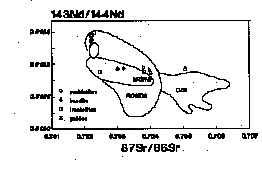
One of the corollaries of the theory of partial melting during sea-floor spreading is that the melt is produced from, and should have identical composition as, the underlying peridotite. This genetic link has been tested in very few places. In present oceans, this topic has been addressed by
a recent isotopic study (Snow et al., 1994) which confirms the genetic link between MORB and abyssal peridotites. In ophiolites, most isotopic investigations have been concentrated on the basaltic crust, and only few studies on the entire ultramafic-mafic association are available. Most of these studies have shown the existence of a cogenetic relationship between the mantle and associated crustal rocks. In some cases however (Xigaze, Tibet; Gopel et al., 1984), isotopic contrasts between ultramafic and mafic rocks have led the authors to argue that ophiolites may contain geological units that originated from different magmatic sources and are distinct in age.
Here we present detailed Sr and Nd isotopic investigations on mafic and ultramafic rocks from an N-MORB
ophiolite in the Internal Liguride Units of the Northern Apennines (Italy), which are interpreted as lithosphere remnants of the Jurassic Ligurian Tethys. This ophiolite consists mainly of mantle ultramafics intruded by a gabbroic complex (troctolites and gabbros) and covered by N-MORB pillow lavas and sedimentary ophiolitic breccias. Mantle peridotites are cpx-poor spinel lherzolites residual after low-degree fractional melting. Their Sr and Nd isotopic composition (on cpx separates) indicate extremely depleted signatures (87Sr/86Sr = 0.702203-0.702285; 143Nd/144Nd = 0.513619-0.513775). Associated intrusive rocks (troctolites and gabbros) and pillow basalts, despite a large 87Sr/86Sr variation (0.702450-0.705555) resulting from seawater alteration, display Nd isotopic compositions typical of MORB (143Nd/144Nd = 0.513038-0.513135), and thus contrast sharply with the peridotites. In a 147Sm/144Nd versus 143Nd/144Nd diagram, whole rocks and separated minerals (clinopyroxene and plagioclase) from troctolites and one gabbro define a linear array which correspond to an age of 164 + 14 Ma. The whole rock data for pillow lavas, as
well as the composition of typical Depleted Mantle (DM) source, also plot along this isochron. Mantle peridotites, by contrast, do not conform to this regression: their Sm/Nd model ages, assuming the DM source, indicate a Permian age of depletion (270 Ma). These results demonstrate that the investigated ophiolite sequence represents the spatial association of Jurassic crustal rocks with older (Permian) mantle peridotites. On a regional scale, this is consistent with recent geologic studies which have inferred that extensional processes leading to the opening of the Mesozoic Western Tethys were already active since Permian. The studied peridotites could therefore record the early upwelling and melting of MORB-type asthenosphere, related to the onset of extension. They subsequently experienced a subsolidus decompressional evolution (accompanied by gabbroic intrusions) which led to their sea-floor emplacement. This study therefore demonstrates that ophiolites may comprise mantle and crustal sections which are not genetically linked by a simple residue-melt relationship and which consequently do not represent "mature" oceanic lithosphere. Instead, these ophiolites may be witness of the early stages of rifting and opening of an ocean.
Gopel, C., Allegre, C.J. & Xu, Rong-Hua, Earth Planet. Sci. Lett. 69, 301-310 (1984).
Snow, E.J., Hart, S.R. & Dick, H.J.B., Nature 371, 57-60 (1994).
Fig. 1: Present-day 143Nd/144Nd versus 87Sr/86Sr diagram for the Internal Liguride peridotites (cpx separates) and mafic rocks (bulks). Also shown are the fields for MORB, OIB and the Ronda peridotites.